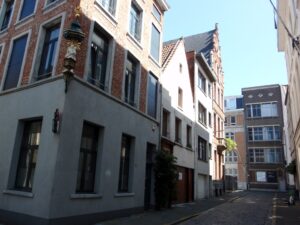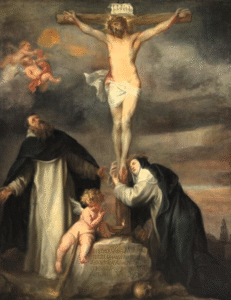Mutsaardstraat: Academy of Fine Arts & Predikerinnenstraat

The female Dominicans nursed father François Van Dyck until his death in 1622. His son Anthony fulfilled his father’s will to give a painting to the sisters, because of their devotion to “certain friendships and loyalties”
[“seeker vrinschappen ende getrouwigheden”]
In translation, the names of these streets, Minderbroedersrui – Minderbroedersstraat, refer to the order of the Friars Minor; around the corner we find the Predikerinnenstraat, and that’s a reference to the sisters Dominicans.
What is left of these orders? A lot more than you may think. Here we stand at the entrance gate of the Academy of Fine Arts, now a department of Antwerp University. The gate offers a vague view of a large nondescript building; until 1797 it was the monastery church of these Friars Minor. At least five paintings by Rubens were hanging in that church and several by Van Dyck and other Antwerp masters.
Rubens had been commissioned by his patron and friend, Nicolaas Rockox, whose house we have just visited. The result was the triptych ‘Christ showing his wounds’, originally hanging in the monastery church, but today at KMSKA. Three others also ended up in the KMSKA collection, coming from the Friars Minor Church: the previously described ‘The Lance Sting/Le Coup de Lance’ by Rubens and/or Van Dyck, the wide-format painting ‘Lamentation of Christ’ by Van Dyck and the accompanying ‘Portrait of Abbot Scaglia’.
It was also in this street that Anthony Van Dyck had his home and first studio. Like all dwellings at the time, it had a name, ‘the Cathedral of Cologne’; it’s a name that will come up again in a moment.
To get a better idea of those earlier baroque times, take a look at house numbers 30 and 32.
The one on the right, no. 30, is called ‘the Dragon’ (de Draeck)‘ and was built around 1628. It is probable that Anthony himself saw it being built. It has a uniform grey look; there is no decoration to distract you. This façade illustrates the transition from the stylish Renaissance to the Baroque.
At house number 32, ‘Van den Kerckhoven’ family, we move to a more elegant period, possibly the third quarter of the 17th century. The abundant decoration on this façade shows exactly how Rubens and Jordaens had become influencers, with their own houses and paintings.
We continue our route through the narrow and angular Predikerinnenstraat. These female Dominicans had fled from another town (Temse). In Antwerp, they first rented ‘the Cathedral of Cologne’; this must have been Anthony’s house, as there was not a second house with that name. Later, the nuns bought a spacious building in an adjoining house block of houses.

For Van Dyck and his family, this is an important place. Anthony’s father François had fallen into financial disgrace shortly before his death – 1622 – and he was probably also in poor health. He received the necessary nursing care from the nuns. To fulfil a promise by his father, and out of his own gratitude, Anthony offered them a painting for their monastery chapel, today in the online collection of the KMSKA.
In this painting, ‘Christ on the cross’ Jesus is joined by saint Dominic, the founder and by Catherine of Siena, the great female saint of the order; you can identify them by their black and white robes. To bring Jesus’s sacrifice closer to home, a faint silhouette of Antwerp Cathedral can be seen in the background.
It’s on display in the online collection of the KMSKA.
Route North:
from the Mutsaardstraat, follow the corner of the Predikerinnenstraat, then turn left over the Klapdorp and cross Sint-Paulusstraat into Lange Koepoortstraat.
Take to the right into Zwartzustersstraat to reach the entrance gate of the Saint Paul’s church at Veemarkt.
